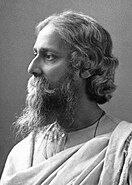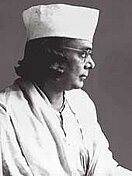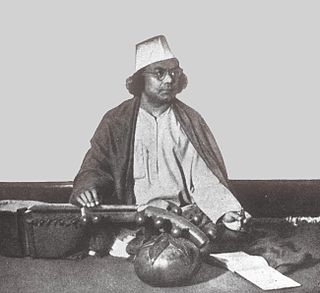
Kazi Nazrul Islam was a Bengali poet, writer, journalist, and musician. He is the national poet of Bangladesh. Nazrul produced a large body of poetry, music, messages, novels, and stories with themes that included equality, justice, anti-imperialism, humanity, rebellion against oppression and religious devotion. Nazrul Islam's activism for political and social justice as well as writing a poem titled as "Bidrohī", meaning "the rebel" in Bengali, earned him the title of "Bidrohī Kôbi". His compositions form the avant-garde music genre of Nazrul Gīti.

Bengali music comprises a long tradition of religious and secular song-writing over a period of almost a millennium. Composed with lyrics in the Bengali language, Bengali music spans a wide variety of styles.

The music of West Bengal includes multiple indigenous musical genres such as Baul, Ramprasadi, Bishnupuri Classical, Kirtan, Shyama Sangeet, Rabindra Sangeet, Nazrul Geeti, Dwijendrageeti, Prabhat Samgiita, Agamani-Vijaya, Patua Sangeet, Gambhira, Bhatiali, Bhawaiya, Bengali Rock.

The Pashchimbanga Bangla Akademi is the official regulatory body of the Bengali language in West Bengal, India. It was founded on 20 May 1986 in Kolkata to act as the official authority of the language and is entrusted with the responsibility of reforming Bengali spelling and grammar, compiling dictionaries, encyclopedias and terminologies and promoting Bengali language and culture in West Bengal. Though the Akademi has no enforcement power over their rules and regulations, they are widely accepted by the Governments of West Bengal and Tripura as well as a considerable number of private publishing houses and institutions such as the Oxford University Press and the Ramakrishna Mission.
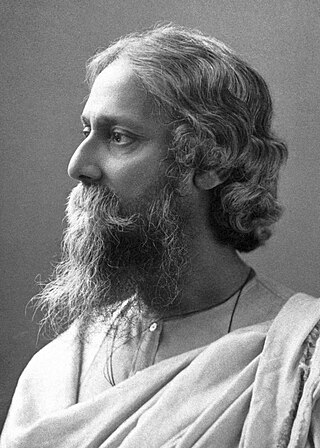
Bengali literature denotes the body of writings in the Bengali language and which covers Old Bengali, Middle- Bengali and Modern Bengali with the changes through the passage of time and dynastic patronization or non-patronization. Bengali has developed over the course of roughly 1,300 years. If the emergence of the Bengali literature supposes to date back to roughly 650 AD, the development of Bengali literature claims to be 1600 years old. The earliest extant work in Bengali literature is the Charyapada, a collection of Buddhist mystic songs in Old Bengali dating back to the 10th and 11th centuries. The timeline of Bengali literature is divided into three periods: ancient (650–1200), medieval (1200–1800) and modern. Medieval Bengali literature consists of various poetic genres, including Hindu religious scriptures, Islamic epics, Vaishnava texts, translations of Arabic, Persian and Sanskrit texts, and secular texts by Muslim poets. Novels were introduced in the mid-19th century. Nobel laureate Rabindranath Tagore is the best known figure of Bengali literature to the world. Kazi Nazrul Islam, notable for his activism and anti-British literature, was described as the Rebel Poet and is now recognised as the National poet of Bangladesh.
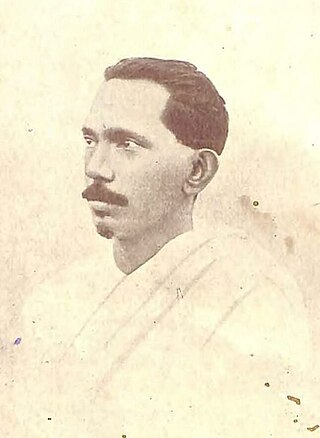
Satyendranath Dutta, a Bengali poet, is considered the "wizard of rhymes". Satyendranath Dutta was an expert in many disciplines of intellectual enquiry including medieval Indian history, culture, and mythology.

Bangiya Sahitya Parishat is a literary society in Maniktala of Kolkata, West Bengal, India. Established during the time of the British Raj, its goal is to promote Bengali literature, both by translating works in other languages to Bengali and promoting the production of original Bengali literature.
The little magazine movement originated in the 1950s and 1960s in many Indian languages like Bengali, Tamil, Marathi, Hindi, Malayalam and Gujarati, in the early part of the 20th century.

The culture of Bengal defines the cultural heritage of the Bengali people native to eastern regions of the Indian subcontinent, mainly what is today Bangladesh and the Indian states of West Bengal and Tripura, where they form the dominant ethnolinguistic group and the Bengali language is the official and primary language. Bengal has a recorded history of 1,400 years.

Shyama Sangeet is a genre of Bengali devotional songs dedicated to the Hindu goddess Shyama or Kali which is a form of supreme universal mother-goddess Durga or parvati. It is also known as Shaktagiti or Durgastuti.
Brajabuli is an artificial literary language popularized by the Maithili poet Vidyapati. His Brajabuli lyrics about the love for Radha Krishna is considered to his best of works. Other poets emulated his writing, and the language became established in the 16th century. Among the medieval Bengali poets who wrote in Brajabuli are Narottama Dasa, Balarama Das, Jnanadas, and Gobindadas Kabiraj.

Himangshu Dutta was a Bengali music director. Amongst several contemporary legendary composers of his time as Rabindranath Tagore, Kazi Nazrul Islam, and Atulprasad Sen, Dutta is renowned for his unique and melodious composition of music. Songs composed by him is usually known as "Himangshu Dutta-er Gaan". The Saraswat Samaj of Dhaka awarded him the title 'Surasagar' for his contribution to Bengali music. He himself was an accomplished singer as well.
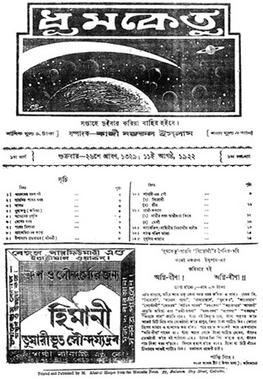
Dhumketu was a bi-weekly magazine edited by Kazi Nazrul Islam which was first published on 11 August 1922. The magazine was started with a four-page format, later elaborated to eight pages. The last issue of the magazine was published in March 1923. Many of the popular poems of Nazrul including Anandamoyeer Agamane, Dhumketu etc.were published in this magazine. Sarat Chandra Chattopadhyay also contributed to the magazine.
Dobhashi is a neologism used to refer to a historical register of the Bengali language which borrowed extensively, in all aspects, from Arabic and Persian. It became the most customary form for composing puthi poetry predominantly using the traditional Bengali alphabet. However, Dobhashi literature has also been produced in the Sylhet Nagri script, as well as in the modified Arabic scripts of Chittagong and Nadia. The standardisation of the modern Bengali language during the colonial period, eventually led to its decline.
Samiul Islam Poluck is a Bangladeshi recitation artist and Anchor. He is a gold medalist at Jatiyo Shikkha Shoptaho in 2001. His full name is A F M Samiul Islam. UNESCO Honor his Fresh Interpretation of Kazi Nazrul Islam's "Bidrohi" Poem for its centennial celebration. He is featured in India's music labels like Saregama and Hisdusthan Records. He is an enlisted artist of Bangladesh Television (BTV). Also he presented various programs in the country and outside the country.
